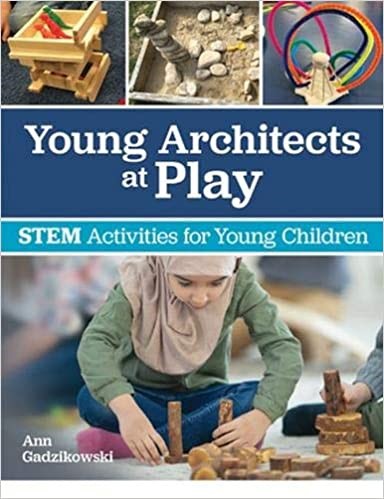Early Childhood Resources Review
Young Architects at Play: STEM Activities for Young Children
Science and Children—November/December 2021 (Volume 59, Issue 2)
By Kelly Russell

by Ann Gadzikowski
November 2020
Redleaf Press
160 Pages
$32.07
Young Architects at Play: STEM Activities for Young Children by Ann Gadzikowski is a comprehensive text that presents activities to do with children as well as the research and philosophy that grounds the practice of including architecture in STEM education.
Architecture is presented as both science and language. Discovering how blocks fit together or how to draw a structure involve concepts of science, engineering, and math. Children’s spatial and reasoning abilities are enhanced through the emphasis of architecture in the early childhood classroom. As children become excited by their creations, they talk to teachers and friends, draw representations, and write about what they are doing.
Gadzikowski pulls from her extensive observations of children interacting with materials—natural, found, as well as commercial products like Jenga or LEGO. Emphasis of architecture’s design principles, patterns, and aesthetic qualities make it clear that with an adult’s guidance, play is much more than meets the eye.
The act of building block structures, sand sculptures, tunnels, and canals offers rich opportunities for language development as children explain their thoughts and negotiate with friends. Moral development is supported as children express their concern for friends and generate rules about their play. (What rules should we have for our structures? How do we comfort a friend who is sad because their structure has fallen? How do I respect the ideas and space of other children?)
The book starts with houses and homes. This is developmentally appropriate as it is a topic for which children naturally have schema. Focusing on homes and progressing to construction of bridges and other infrastructure allows children to move from the familiar to the more novel. They know that houses have a roof, walls, and doors. They understand that a house is where people sleep, eat, and live their lives with family. Gadzikowski calls to attention the emotional safety of children whose experiences at home may not be that houses are safe places.
The importance of children’s physical as well as emotional safety is addressed in every activity suggested. Gadzikowski leads the reader through simple and more intricate activities and explains the complexities of such play. The role of the teacher in choosing materials, allowing opportunity for discovery, and pushing learning further is emphasized and supported by organized activities. Teachers are offered both the how and the why of architectural play. Gadzikowski provides big ideas and open-ended questions that will support teachers as they deepen children’s experience and understanding.
The overarching theme of this book is how to honor children as curious architects. Each of the 20 suggested activities are presented in a format that helps the reader understand the intentionality that underlies what some may see as play. This is accomplished by outlining the purpose, materials, provocations, considerations for safety, questions that lead children to big ideas, and the next steps to take after the activity. This format is consistent across all activities, which makes Young Architects at Play: STEM Activities for Young Children an effective resource for teachers of preschool and early education. Teachers will gain an understanding of what children know about structure and learn ways to use that innate interest to create valuable learning experiences. ●
Kelly Russell (krussell@bsc.edu) is an associate professor of education at Birmingham-Southern College. She spent 10 years teaching first grade and now teaches preservice teachers how to bring STEM into the classroom. Dr. Russell is editor of the Early Childhood Resource Review column in Science and Children.
Instructional Materials Literacy STEM Early Childhood


